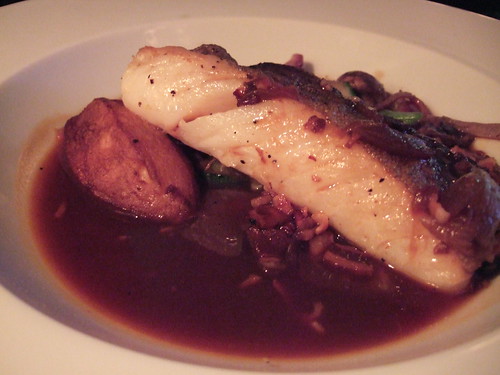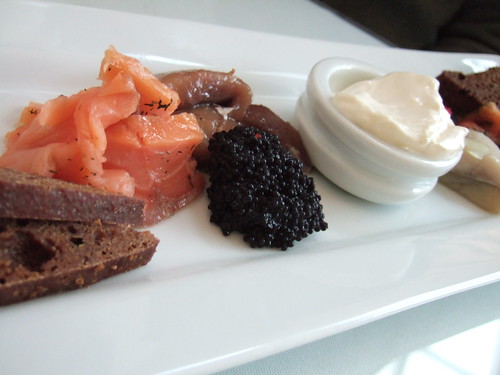For our first dinner in Reykjavik, we ended up at Vin og Skel on a small alley off the main shopping street of Laugavegur. We didn’t have reservations, but when we walked in, the waitress led us to the only two-person table upstairs. We were surrounded by two large groups. It felt like we were crashing two different parties. Their entire menu was written on a blackboard which reminded me of any laid-back New England seafood restaurant, but the seafood at Vin og Skel was better than any I’ve had here in the States.
Owner Kristjan Noi is not shy about experimenting, but the best dishes were the simplest. A pail of mussels was comforting in some broth flavored with leeks. My glass of white wine wasn’t as cold as I would have liked, so the mussels made me wish I ordered beer instead.
My main dish, part of the “surprise menu” I selected, was a lobster-catfish-monkfish combination with white sauce. The dish was a little too salty but the lobster and the fish were the freshest I’ve had in a long time. Both fish were cooked just right: the meat tender with some give. The Dr.’s bacalao, or cod, an abundant fish in Iceland, was also really good. Unfortunately, it was also oversalted. His came with brown stock and potatoes, which were perfect to combat the chill coming in through the French doors next to the kitchen.
They were offering minke whale carpaccio as a special. I am currently doing research about whaling in Iceland to see if the meat for sale in their markets are from scientific research only, but that night, the Dr. and I simply couldn’t resist. The whale meat was of a deep-burgundy red, like beets, sliced thinly and drizzled with olive oil. The tops of what looked like radish greens had the perfect bitter taste to accompany the beefiness of the whale. It wasn’t at all fishy and it tasted like a very expensive cut of beef. The Dr. felt more awful than I did because he loves to fish, but when asked if he’ll eat it again, say in Japan where it’s also “allowed,” he said yes.
We ended our night with creme brulee served with a dainty gooseberry on top. It came with my prix fixe. Our temples were pounding because of the salt we’ve consumed and my eyes were a little tired from squinting all night because the space was not well lit. In the end, both helped us fork over our $200 with only a glass of wine and a Pillsner Urquel. We saved a lot of money while we were on the road but we surely blew a lot just in one night!
Vin og Skel is on Laugavegur 55, + 354 534-4700
Where to stay in Reykjavik for cheap: Reykjavik Hostel
Related post/s:
Vin og Skel photos on Flickr
Carpe Diem in Reykjavik offers puffin
Driving around South Iceland














